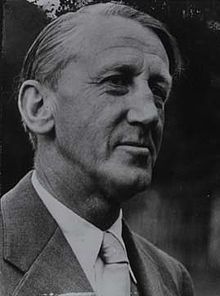Kaare Klint
Kaare Jensen Klint (born December 15, 1888 in Frederiksberg , † March 28, 1954 in Copenhagen ) was a Danish architect and furniture designer .
biography
Kaare Klint studied architecture with his father Peder V. Jensen Klint and Carl Petersen at the Copenhagen Academy and painting with Johann Rohde at the Teknisk Skole . He developed his first neoclassical furniture in 1914 together with Petersen for the art gallery in Fåborg . From 1917 he worked as a freelance furniture designer and worked for Fritz Hansen and Rudolf Rasmussen as well as for the Thorvaldsen and the Kunstindustrimuseet in Copenhagen.
In 1924 Klint founded the new department for "Furniture Art and Interior Design" at the Danish Academy of Fine Arts in Copenhagen. His students included Mogens Koch and Børge Mogensen . From 1944 Klint was a professor of architecture there. His style is characterized by a clear, simple and honest design language down to the last detail. The lines are simple and straight and often based on the material. The furniture is partially prefabricated and manufactured with a high level of craftsmanship.
plant
Klint is considered one of the most influential exponents of modern Scandinavian design and the “father of the Danish furniture school”. He was particularly interested in the ergonomics of his furniture. He tried to adapt them as precisely as possible to the human proportions, on which he did his first research as early as 1913 and was thus the first designer to seriously deal with anthropology . Together with his students, he also researched the functionality of a piece of furniture, which laid the foundation for the later Scandinavian style.
Klint's first popular chair was the Fåborg chair made of mahogany wood with a woven backrest and cowhide covers for the seats, designed for the Fåborg Museum . The chair, later manufactured by the Rasmussen company, is typical of Klint's style due to the synthesis of tradition and modernity. In 1933, Klint developed the functionalist safari chair made of ash wood , leather and cotton cloth, the prototype of which was also foldable and height-adjustable. In addition to these chairs, Klint's classics include the folding chair from 1927, the church chair 4133 from 1936 and the deck chair from 1936.
His work as an architect included the conversion of the Friedrichskrankenhaus into an art industry museum (now the Design Museum Danmark ) in the early 1920s. In 1940 he completed the work of his late father Peder Klint at the Grundtvig Church .
Awards
In 1935 Klint received the Grand Prize at the Exposition Universelle et internationale in Brussels for his work, and in 1954 the CF Hansen Medal .
Individual evidence
- ↑ a b c d e f Thomas Heider, Markus Stegmann, René Zey: Lexicon Internationales Design. Rowohlt Taschenbuch Verlag GmbH, Reinbek near Hamburg 1996; Pp. 166-167. ISBN 3-499-16346-2 .
- ↑ Biography Kaare Klint ( Memento from May 6, 2008 in the Internet Archive ), art directory GmbH (accessed on March 14, 2015)
- ↑ Kaare Klint in Britannica online (English)
literature
- Thomas Heider, Markus Stegmann, René Zey: Lexicon Internationales Design. Rowohlt Taschenbuch Verlag GmbH, Reinbek near Hamburg 1996; Pp. 166-167. ISBN 3-499-16346-2 .
- Gorm Harkær: Kaare Klint . 2010, Klintiana, ISBN 978-87-994184-2-8
Web links
- Pictures of his work
- Appreciation of Klint (English) Website of the Danish state Denmark.dk
| personal data | |
|---|---|
| SURNAME | Klint, Kaare |
| ALTERNATIVE NAMES | Klint, Kaare Jensen (full name) |
| BRIEF DESCRIPTION | Danish architect and furniture designer |
| DATE OF BIRTH | December 15, 1888 |
| PLACE OF BIRTH | Frederiksberg Commune |
| DATE OF DEATH | March 28, 1954 |
| Place of death | Copenhagen |

